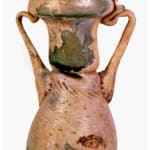Roman Glass Amphora, 4th Century CE
Glass
2.75 x 4
G.0149
Further images
The history of glass making before the Industrial revolution can be separated in two stages: in the first, which began in the 3rd millennium BC and ended in the period...
The history of glass making before the Industrial revolution can be separated in two stages: in the first, which began in the 3rd millennium BC and ended in the period from 100 to 50 BC, craftsmen discovered how to transform raw materials into glass and how to make vessels and other objects either with moulds or by forming a molten glass around a removable core. Both techniques were labour-intensive and were seldom made in big quantities. In the second stage, beginning in the 1st century AD in the Syro-Palestinian region, glass workers found that molten glass could be formed by inflation and manipulation with tools. Glass blowing enabled them to make quickly a wide range of shapes, thus widening its market. However, after the 2nd century AD, glass is generally found in a more confined area. The change appears to have taken place under the Flavian Emperors (69-96 AD), an era that in many ways represents a watershed in the history of glass making. It is from this time onwards that glassblowing in the East and the West developed along independent lines, the only exception being fine tableware decorated with special techniques, which was probably due to the still unifying factor of the Roman Imperial administration.
Yet, the most prolific period in the history of glass in the Eastern Mediterranean was during the late Roman Empire, when Egypt, Palestine, Syria, Cyprus, Asia Minor and the north Pontic region all had flourishing glass industries. With the increased demand for glass, regionalism became the dominant factor in the production of glass vessels. Marked regional differences existed not only between the glass made in Syria, Jordan and Palestine, but even between different parts of Palestine (inland vs coast; Galilee and Phoenicia vs Judea). The glass industries of these regions experienced a prolonged period of growth, and the late Roman and early Byzantine period were by far the most important not only in terms of absolute output but also in terms of typologies used. Only during this period, glass was finally used by different strata of societies, sometimes even replacing pottery for certain functions.
The Palestinian glass industry flourished from the 4th to the early 5th century, following the rule of the Roman emperor Diocletian (284-305), when the region enjoyed a time of relative peace in spite of economic instability. When Constantine the Great finally emerged as sole ruler in 324, Palestine benefited from the fact that he targeted Jerusalem and the Holy Land as main recipients for his reconstruction program. Exempted from personal taxation by an Imperial edict in 337, a large number of skilled craftsmen profited greatly from the economic boom.
Yet, the most prolific period in the history of glass in the Eastern Mediterranean was during the late Roman Empire, when Egypt, Palestine, Syria, Cyprus, Asia Minor and the north Pontic region all had flourishing glass industries. With the increased demand for glass, regionalism became the dominant factor in the production of glass vessels. Marked regional differences existed not only between the glass made in Syria, Jordan and Palestine, but even between different parts of Palestine (inland vs coast; Galilee and Phoenicia vs Judea). The glass industries of these regions experienced a prolonged period of growth, and the late Roman and early Byzantine period were by far the most important not only in terms of absolute output but also in terms of typologies used. Only during this period, glass was finally used by different strata of societies, sometimes even replacing pottery for certain functions.
The Palestinian glass industry flourished from the 4th to the early 5th century, following the rule of the Roman emperor Diocletian (284-305), when the region enjoyed a time of relative peace in spite of economic instability. When Constantine the Great finally emerged as sole ruler in 324, Palestine benefited from the fact that he targeted Jerusalem and the Holy Land as main recipients for his reconstruction program. Exempted from personal taxation by an Imperial edict in 337, a large number of skilled craftsmen profited greatly from the economic boom.
Literature
V1





